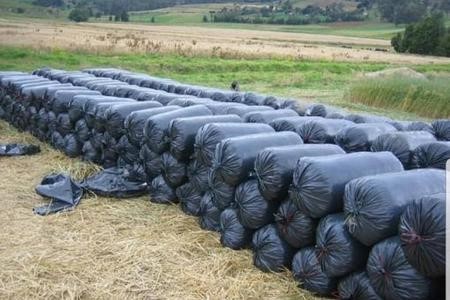DETAILED PROJECT REPORT (DPR) FOR SILAGE BALING UNIT IN INDIA
Silage-making is a fermentation process aimed at preserving forage in its wet state away from air. One is seeking to lose minimum dry matter and nutritional value and to avoid creating products toxic to the animal. Good silage is light brown in colour, has a sharp taste and little smell as its lactic acid content is right. It is very stable and can be kept for years if required.
- India where over 75% farmers are small and marginal holders, livestock is the main source of livelihood for majority of the rural population. It is the backbone of Indian Agriculture contributing 7% to national GDP. India has the highest number of livestock population in the world (512 million, 19thLivestock Census 2012), representing over 17% of the world livestock population.
- About 65-70% of the total cost of livestock farming is attributed to feeding and hence fodder and feed are an integral part of animal Husbandry and there is no shortcut to sustain livestock husbandry, without addressing the development of fodder and feed resources
- With 176 million tonnes milk production, India is the largest milk producing country globally. The milk production has almost tripled since 1990-91 with a growth of over 4 percent annually which has increased to almost 5 percent in recent years (Niti Ayog report)
- However, the average milk yield of cattle in India is very low. While the average milk yield of cattle in the world and Europe is 2038 kg and 4250 kg per lactation respectively, the average milk yield of Indian cattle is only 990 kg because of fodder management practices. (Source – Animal Husbandry, MS)
As per NIANP-ICAR, there is shortage of green and dry fodder to the extent of up to 32% and 23% respectively. However, twice a year the problem gets very acute due to shortage of green fodder for cattle. This is because availability of fodder has a huge dependence on monsoon performance. There is abundant fodder available for cattle during the monsoon season but during lean periods or drought conditions, the fodder availability decreases remarkably. This periodic unavailability poses a great challenge to not only sustain milk production but also the health of the animal population, hence it is very necessary to provide abundant fodder to the cattle during lean periods as well.
(Source: NIANP 2012)
- Prolonged preservation of Fodder in the form of Silage was a potential solution, but largely confined to the pit method in some large government /private locations.
What is Silage?
- Chopped green fodder packed in anaerobic condition gets converted in to silage.
Advantages of Silage making
- Ensures regular supply of fodder to the dairy animals
- Ensures uniform quality and digestibility of fodder during different seasons.
- Enhances milk yield of dairy animals by ensuring fodder supply, especially during lean period.
- Helps in maintaining better health of animal, as parasites present in different stages of green fodder are destroyed during ensiling.
Fodder crops suitable for silage making
- Quality silage can be prepared from cereal green fodder i.e. Maize, Sorghum, Bajra, Hybrid Napier, Oat, etc. Cereal green fodder is preferred as these are rich in soluble carbohydrates and hence are more suitable for fodder ensiling. Sugar is utilized in fermentation process to make lactic acid by microorganism. Lactic acid act as preservative also helps in improving digestion of fodder and proper utilization by ruminants.
- Silage based on Maize crop is mostly used in Dairy industry as it is very nutritious with 8-9% protein.
- In India, maize is the 3rd most important food crops after rice and wheat. The maize is cultivated throughout the year in different parts of the country for various purposes including grain, fodder, green cobs, sweet corn, baby corn, popcorn etc.
- The major maize growing states that contributes more than 80% of the total maize production are Andhra Pradesh, Karnataka, Rajasthan, Maharashtra, Bihar, Uttar Pradesh, Madhya Pradesh, Himachal Pradesh. Maize can be grown in all seasons viz Kharif (monsoon), post monsoon, Rabi (winter) and spring
- Under proper storage condition, silage can be stored even up to 2 years.
Different types of Silage making
- Various modes of making silage are being used namely bales silage, vacuum packing, bag silage etc of which mechanised application of PE Bale silage is flourishing the most.
Bale silage
- To conserve and store green fodder for livestock using the natural process of fermentation.
- Baled silage is prepared by preserving chaffed green fodder in anaerobic fermentation method. In anaerobic condition i.e. no air inside a bale in presence of microorganisms, sugar contained in green fodder is converted into lactic acid, which helps process of fermentation of green fodder in to silage.
- Almost all forages can be ensiled to some extent, maize being most popular.
Process & Features
- Moisture content, chop length, silage distribution and compaction (minimises aerobic activity & maximises anaerobic activity) can greatly influence the fermentation process and losses.
- Finely chopped high quality fodder with 10% carbohydrate are fermented with/without inoculant as per local needs and by compacting.
- Tightly packed chopped green fodder with UV stabilized PE Bale silage film are stored for proper ensiling (inner and outer layer).
Packaging Material: Technical Textile (HDPE Net) and Bale silage film
- Outer layer is UV stabilized PE bale silage film (Relene LLDPE Octene film grade has now been stabilized and being used in making bale silage film, there are no. of supply chain on Pan India basis).
- Inner layer may be either Technical Textile HDPE Net (UV stabilized, 9-10 gsm, Relene HD raffia grade) or UV stabilized PE bale silage film depending upon type of machines. Technical Textile HDPE Net enables hassle free baling, dimensional stability.
Can be used round the year as a high nutritious feed for better milk yield and higher SNF in dairy animals, as a substitute for green fodder.
Advantages of Bale silage
- Easily digestible, high in protein.
- Less dependent on weather conditions, provide fodder round the year.
- Can be stored in the field and easily transported within farm.
- Limited capital investment, minimum labour, low transport and storage cost.
- Used Bale silage film can be effectively recycled.
Machines for Bale Silage:
- More than 150 bale silage machines of different capacities and make are in operational in India both imported (Orkel, Fateh Makina, Chinese, etc) and indigenous (Bakhsish Inds, Cornext, etc), Bale silage varies from 80 kgs to 450 kgs.
Promotion Bale silage:
- Gradual depletion of green pasture across India is a major growth deterrent of milk production GOI spends lot of money per year on fodder purchase or as subsidy for green fodder storage using traditional methods.
- However, the shortage of fodder during lean season is growing as the age-old silo digging process is labour oriented and highly capital intensive.
- Starting from the initial concept development stage to the current cusp of the silage packaging revolution in the country, efforts continued to catalyse the change in the Dairy sector.
- To address fodder scarcity issue arising out of drought in villages, Animal Husbandry, Maharashtra announced 3 schemes -i) Raje Yashwantrao Holkar scheme -to install 25 mini silage bale wrapper machine ii) Nanaji Deshmukh Krishi Sanjivani Yojna (Pocra) – subsidy on purchase of Bale silage machine in all drought affected villages iii) Tender for supply of huge quantity of silage.
- AHD-AP identified Livestock as a growth engine & offer subsidy on Bale silage machines. Also issued a tender for purchase of huge quantity of Bale silage.
- Success stories in Punjab: Silage industry has well established in Punjab area. Punjab Dairy Development Board has recently included Bale silage machine in the notification. Also, Agriculture department, for the first time included in notification, the usage of drip pipe for maize crop with subsidy, a basic crop, raw material for making Bale silage. Use of micro irrigation and mulch in future will help in enhancing yield of the crop, hence above development is going to give big boost to Silage industry particularly Bale Silage in Punjab.
- The acceptance of PE Bale silage continues to grow leaps and bounds at various corners of the country now, currently its requirement is @ 10.5 lakh T, which is expected to grow to 10 Million Tons in next 5 years’ time.
Bale silage film:
Bale silage film (Recycling):
- After usage of Silage, the Agri bale silage film should not be thrown in the field and can be sold to recyclers which fetches some value of the film to the farmer, Dairies. This recycled film can be converted in to useful products like furniture garden benches, pallets, Lapeta pipe, drip, etc
Potential of Silage Industry (all variants) in India (Billion Rs):
| Potential Silage Industry | |
| Total Number of Cows and Buffaloes (Cr): | 17.1 |
| Average no. Green Fodder Scarcity (days per year): | 150 |
| Minimum Amount of Silage to be fed to Animal /day (Kg): | 10 |
| Amount of Silage Required in India (Cr. Tons): | 25.65 |
| Average Market Price of Silage (Rs per Ton): | 5500 |
| Potential Industry size in (billion Rs): | 1410 |
| Potential: Silage packaging material (Bale silage / Bag) | |
| Qty of Bale silage/ Bags required to pack 5% 0f total potential (Cr. Tons) | 1.2825 |
| Price of Bale silage / Bag (Rs/T) | 140000 |
| Potential for Bale silage/ Bags required to pack 5% total potential (Billion Rs) | 1795 |
| Total Potential of Silage (including packaging) Industry (Billion Rs) | 3206 |
- We look back with satisfaction, and look at the current scenario with firm belief to be leading the dairy sector to a way towards solving the round the year fodder availability in the country
- The keen interest of the Co-operative and private sector in the business of silage with large capital infusions, the acceptance of packed silage among dairy farmers and the readiness of farmers to take up fodder crops as a remunerative production option plus the state governments supporting the process with subsidies for machineries are all setting into motion a cycle of hope which in the future would grow into a great revolution.
- We look forward with hope, that silage as a key fodder input in the dairy sector, would alleviate the major constraint of round the year availability of fodder in the dairy sector
- The expected announcement of National Dairy Plan, phase 2 (NDP-2), promoted as Mission Milk, having outlay of 8000 crores, spread over 5 years, will provide further thrust in enhancing milk processing capacity and infrastructure for which silage will play a major role on the feed input side of year-round nutritious fodder availability across the country!
Conventional Balers
Conventional balers are automatic tying machines with reciprocating plungers those produce bales of rectangular cross-sections. The number of wires or twines placed around each bale classifies them. The three-wire balers commonly used in areas where high percentage of hay is sold and transported commercially. Most field balers are pull-type operated by a tractor, but self-propelled balers are also available commercially. Pull-type balers are available with either a PTO drive or mounted engine type. PTO driven pull-type balers are very common now days (Fig. 4).
Plunger-type field balers have following functional components:
- a) A unit to pick-up hay from windrow and elevate it.
- b) A conveyor to move the hay to the bale chamber entry.
- c) A packer to place the hay in the chamber while plunger is on its retracted stroke.
- d) A reciprocating plunger to compress the hay and move it through the bale chamber.
- e) Means of applying forces to resist the movement of hay through the bale chamber and thus control the degree of hay compression and the resultant bale density.
- f) An automatic metering device for controlling bale length.
- g) means of separating consecutive bales and placing the wires or strings around each bale.
- h) Automatic tying devices that operate when the bale reaches the pre-selected length.
Field balers employ cylinder-type-picking units with spring teeth on cam-controlled tooth bars. The counterbalance springs supports the pick-up mass. The peripheral speed is generally kept higher than the forward speed. Floating cross-conveyor auger and packer fingers push hay into the chamber when the plunger is on its retracting stroke. As the plunger moves on its compression stroke, each new hay charge is compressed until plunger force becomes large enough to move the completed bales along the chamber. On the return stroke of the plunger, fixed wedges and spring-loaded dogs hold compressed hay. The density of bale is affected by the type of material, moisture content and the total resistance that the plunger must overcome in moving the material through bale chamber. One of the problems encountered in baling hay is the change of bale density as the moisture content varies from one part of the field to another or it changes with time. The density of compressed bales can be adjusted by density setting screws provided at exit of baling chamber. The wire is placed across the periphery along the length of bale at two locations. The machine has, therefore, two wire twisters, wire cutting discs and needles. The binding mechanism is put into operation by a clutch actuated by clutch lever, which in turn pressed by a cam mounted on a notched metering wheel. The straw baler can also be used as hay baler.
Baler is also called packing machine which picks up loose hay or straw, Compress it into bales of even size & weight then ties them with twines or wires and finally the completed bale is discharged from the back of the baler to ground. Fig. 4 shows the baler in field operation. Fig. 5 and Fig. 6 shows the schematic view of straw baler and mechanism for varying bale length respectively.
Classification: Baler can either be classified on the basis of power source or on the basis of types of bales.
- On the basis of power source
- PTO operated
- Auxiliary engine
- Self-propelled baler
- On the basis of types of bales
- Rectangular Bales
- Round Bales
Functional Components: Baler mainly consist of following units:-
- Pick Up Unit
- Feeding Unit
- Compressing Unit
- Knotting Unit
- Conveying Unit
Description of functional components: Most of the field balers employee cylinder type pickup units with spring teeth on cam control tooth bars, loading cross conveyor auger and packer. Windrow pickup, conveying and feeding device is shown in the Fig. 7.
Compressing unit: In the compressing unit firstly feeder teeth pull the hay into bale chamber, plunger compresses the hay into bale chamber and when plunger is at rear position knotting device makes the knot.
Compressing hay and controlling bale density: The plunger, fixed wedges, spring loaded dogs are used to compress hay. Method of controlling bale density is done by squeezing together two sides or all the four sides of the bale chamber at the discharge end. There are two types of the bale tension control devices used which are (i) Automatically controlled hydraulic type; and (ii) Spring type.
Automatic wire tying devices: There are two types of automatic wire tying devices which are: (i) Loop twist type, and (ii) Straight twist type. Each type has a clamping device that holds the end of wire. When the needle has moved to its extreme penetration position, the clamping device is moved to release wire end that had been held during bale formation then, shear the wire that has been brought by needle and finally clamp the wire from needle which will become held end for next bale. Fig. 8 and Fig. 9 shows the two types of automatic wire tying devices respectively.
Rectangular bales: The hay lying in the field gets collected by the revolving pick up drum. The pickup tynes rotates in opposite direction to the land wheel. The cross auger rotates continually and delivers the crop to the packer arms or feeder teeth which pull the hay into the bale chamber. Then it`s feed to the high pressure press. The piston of the high pressure press works 69 to 80 stokes per min. and press the hay in compact form. The Ram is fitted with knife blade on straw entrance side which cut the straw when the Ram is in the onward stroke. When the bales take up the shape the tying unit operates automatically and bind the bales at low places. After binding the bales, the binding unit of the baler, throw that on ground. Rectangular bales generally vary from 14″ x18″ to 16“x18″ and 32″ to 42″ in length. The weight of each bale 15 to 40kg. The Schematic view of baler giving rectangular bales is shown in Fig. 10.
Baler giving round bales: In case of round bales, the pickup lifts the hay from the windrow and carries it between steel compression rollers. Six bands or belts pass over the lower drive roll and also over a trip roll and a tension roll. The upper part of the mechanism consists of six more bands, which passes through a small drive roll, a tension roll and a trip roll. As the bale is rolled, the upper belt arms extend the tension spring and tension increases in the upper belts to squeeze the ball. When the belts have completely extended a relative value, the hydraulic rear gate cylinder opens and triggers the gate bottom to move to the rear until the maximum bale diameter is reached. When the full bale diameter is reached, twine is feed into the bale chamber with the hay. When the bale is twine wrapped, the twine is cut off. Finally the hydraulic controlled gate is raised and the bale is discharged. Most of the round bales are of 1.5 to 2.1 m in diameter and 1.2 to 2.1 m in length. The Schematic view of baler giving round bales is shown in Fig. 11.
Power Transmission: The PTO drive is transmitted through a heavy flywheel to a gearbox. Here a pair of bevel gears put the drive through a 90 degree. A crankshaft on the gearbox output shaft gives the plunger it’s back and fro motion. Drive to pick up, auger, packers and tying unit is also taken from the main gearbox. Most of the drive is by chain and sprockets.
Baler capacities: Baler capacities are affected by:
- Size of the bales
- of the plunger stokes per min
- the amount of power available
- the durability and reliability of the machine
Expected break down in balers:
- Overloading due to picking up of foreign objects or slogs of hay and careless operation
- choking due to the excessive clogging of the straw
- Failure of the machine parts like plunger, fly wheel and bolts
Straw balers can be used either in combine-harvested paddy field or in the combine-harvested rice field where stubble shaver has been used for cutting of standing straw. The forward speed of baler generally varies between 2 km/h to 3.0 km/h. The fuel consumption is in the range of 10-11 l/ha. The field capacity is 0.25 ha/h to 0.35 ha/h. The size of rectangular bales can be varied from 80 x 45 x 45 cm to 150 x 45 x 45 cm and bale weight can be varied from 15 to 45 kg. The number of bales formed may vary from 80 in combine-harvested field and 170 in stubble-shaved field. The bales so formed by the baler may be transported (Fig. 12) to the paper mills or to the location where it can be used for electricity generation.

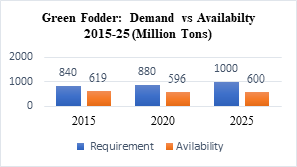


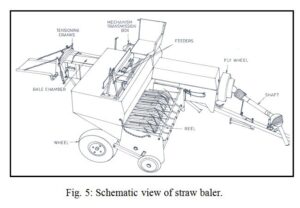
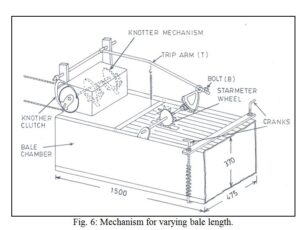

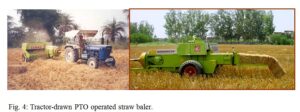

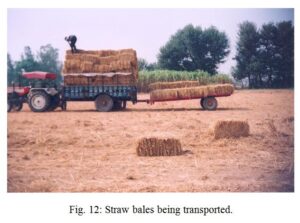
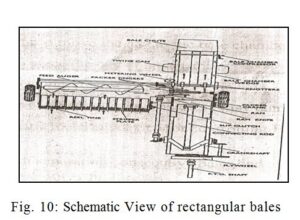

Detailed Project Report of MINI SILAGE BALING UNIT
Compiled & Shared by- Team, LITD (Livestock Institute of Training & Development)
Image-Courtesy-Google
Reference-On Request.


